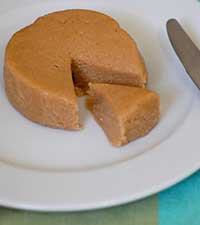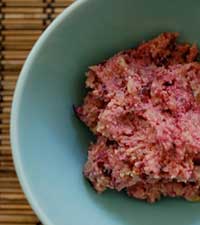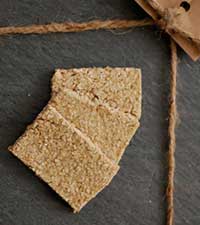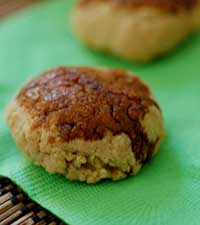It’s January, which means that all across America, people are resolving to eat better. And that means that they’re also resolving to smugly tell you about it. But the next time your newly gluten-free, sugar-free, and dairy-free co-worker insists that you need to jump on the kale-acai smoothie express, just be thankful that this isn’t the turn of the century. Because back in the late 1800s and early 1900s, diet adherents really knew how to twist the guilt knife.
Take, for example, this introductory passage from 1912’s Unfired Food and Tropho-Therapy:
If you have concluded that “Ignorance is bliss” and prefer to cater to your perverted appetite with your favorite predigested food, which is so tempting, so sweet in the mouth, so easy to gulp, so smooth to swallow, so stimulating, and so fashionable, then lay this book aside until you have learnt through disease and pain that it pays to adopt the natural and moral diet.
This book is so judgey that, before the blank pages where you can write your own recipes, there’s this note: “Do not scribble every trash you find on these pages, for it will be disgusting to you in the future.”
Despite the old-timey title and brimstone-fueled language, however, the suggestions in Unfired Food and Tropho-Therapy (and many other diet books from the same time period) aren’t that different from diets today. It’s easy to think that modern eating plans are a series of trendy new ideas — Atkins giving way to South Beach, South Beach giving way to The Skinny Bitch, and so on. But really, while these books might have new science to back up their suggestions, we humans have known what’s good for us for a long time (even if we don’t want to do it). This quote from Unfired Food and Tropho-Therapy sounds like it could be pulled from a book currently on the shelves at Barnes & Noble:
The present diet of the uninformed civilized world is a most perverted one. It consists mainly of flesh, white flour (starch) bread, refined sugar, and animal fats. It is very, very poor in organic salts but rich, yes – remarkably rich in drugs.
Yup, no matter what trendy names modern diets have, most of them have been done before.
Tropho-therapy is similar to the modern raw foods movement (of which Demi Moore and Alicia Silverstone are both reportedly fans). Vegetarianism has been practiced in one form or another for thousands of years — infamous sanitarium-owner/enema fan John Harvey Kellogg was a proponent of a very simple vegetarian diet, as well as a noted condiment hater.* Low-carb diets go back years and years as well. Frenchman Jean-Anthelme Brillat-Savarin promoted one in the early 1800s, and low-carb circled back around in the early 1900s when Arctic explorer Vilhjalmur Stefansson proposed a diet based on the eating habits of the Inuit.**
Really, there are just two main differences I found between turn-of-the-century diet fads and modern diet fads. First of all, the goal of the old-timey diets was always the prevention and cure of disease. Sure, you can argue that’s also a goal of today’s diets, but come on — everybody really wants to be sliding into their skinny jeans. Turn-of-the-century diets were more life and death — remember, this was a time before antibiotics, when gout was a common ailment instead of an amusing old-timey reference, and an outbreak of cholera could kill over 10% of a local population. Hell, there were still literal cesspools attached to houses.
The second difference between the old diets and modern diets? The recipes from the 1800s and early 1900s diet cookbooks I researched taste like hot cardboard (or, in the case of the “unfired” recipes, cold cardboard). Yes, on the surface, a text like 1854’s New Hydropathic Cook-book has similar principles to Michael Pollan – eat mostly plants; don’t bury your food in fat and sugar. But the book also preaches a complete abstinence from salt, vinegar, and lemon, aka “flavor.” Kellogg had a similar philosophy — but John Harvey, my man, when you’re making a cracker whose two ingredients are grain and water, you need to put some damn salt in it.
I get it — for doctors who saw culinary excess as the primary problem plaguing the health of Americans, stripping food down to its basics seemed like a good way to course-correct. That’s still the essence of many eating plans today (but with more flavor). But for many of these diets, there was more to the tastelessness. Food wasn’t just something that provided energy, but it was a tool for traveling the path of truth and righteousness. Tropho-therapy wasn’t pitched as a way to enjoy good, healthy food, but as “the key that unlocks the door to physical, mental, moral, and spiritual salvation.” And, by relation, many dieters had a certain ascetic pride in eating food that truly wasn’t “perverted.”
That’s all well and good, if you feel like you need saving. But as any person who has tried an extreme eating plan can tell you (including me that time in 2006 when I tried to only eat hummus, quinoa, and steamed spinach for a week) — if you want to stick to a diet, it needs to taste good. Thankfully, modern diets (mostly) recognize that.
So happy 2014, everyone. I encourage you to eat well this year — both in terms of health and enjoyment. But if you feel like you also need to follow the blazing path of righteousness (and/or need a very bland cracker when you’re sick), check out the recipes below.
* In 1875’s The Household Manual of Domestic Hygiene, Foods and Drinks, Common Diseases, Accidents and Emergencies, and Useful Hints and Recipes, Kellogg wrote, “Condiments are innutritious…they irritate the digestive organs, impairing their tone and deranging their function.”
** Of course, there have always been crazy diet fads that fizzled faster than you can say “Hollywood Cookie Diet.” In the early 1900s, Fletcherism recommended chewing your food dozens and dozens of times – then spitting it out instead of swallowing, assuming you could get all of the nutrients you needed just by masticating. Milk Diet as a Remedy for Chronic Disease, originally published in 1905, recommended consuming…well, just milk. • 6 January 2014
| Wedding Cake |
 Of all the unpalatable weirdness in Unfired Food and Tropho-Therapy, I think this takes the…y’know. It’s not that it’s the worst-tasting recipe in the book, it’s just that this round, grainy-sweet brick of tan food matter is so very, very far from the celebratory dish it’s trying to emulate. Of all the unpalatable weirdness in Unfired Food and Tropho-Therapy, I think this takes the…y’know. It’s not that it’s the worst-tasting recipe in the book, it’s just that this round, grainy-sweet brick of tan food matter is so very, very far from the celebratory dish it’s trying to emulate.
From Unfired Food and Tropho-Therapy, 1912 |
| Cranberry Butter |
 This recipe is symbolic of most of the recipes in Unfired Food and Tropho-Therapy, which are almost all some version of a raw fruit mashed up with a raw nut. If you add parsley to this, it becomes “cranberry cheese”/more depressing. By the way, according to the pictures in the book, the “flaker” tool used on the peanuts is just a renamed meat grinder. This recipe is symbolic of most of the recipes in Unfired Food and Tropho-Therapy, which are almost all some version of a raw fruit mashed up with a raw nut. If you add parsley to this, it becomes “cranberry cheese”/more depressing. By the way, according to the pictures in the book, the “flaker” tool used on the peanuts is just a renamed meat grinder.
From Unfired Food and Tropho-Therapy, 1912 |
| Crisps |
 I prefer to think of these bland-but-quick-cooking Kellogg inventions as “emergency crackers.” If you add salt and spread them with some jam, pesto, or…anything with flavor, they’re not that bad. I pulsed oats in the food processor to make mine, and I cooked them at 400 degrees until they just started to brown at the edges. I prefer to think of these bland-but-quick-cooking Kellogg inventions as “emergency crackers.” If you add salt and spread them with some jam, pesto, or…anything with flavor, they’re not that bad. I pulsed oats in the food processor to make mine, and I cooked them at 400 degrees until they just started to brown at the edges.
From The Household Manual of Domestic Hygiene, Foods and Drinks, Common Diseases, Accidents and Emergencies, and Useful Hints and Recipes, 1875 |
| Improved Jumballs |
 This is the best recipe I tried out of any of these books, and it’s still…imperfect. I halved the recipe below, but it was nowhere near a dough, so I added a second egg and a little water. Then the dough wasn’t super workable, so I just made cookie rounds instead of the playful shapes suggested. I used coconut oil for the oil and cooked them at 350. These dense, not-too-sweet cookies are pretty good for dipping into coffee. This is the best recipe I tried out of any of these books, and it’s still…imperfect. I halved the recipe below, but it was nowhere near a dough, so I added a second egg and a little water. Then the dough wasn’t super workable, so I just made cookie rounds instead of the playful shapes suggested. I used coconut oil for the oil and cooked them at 350. These dense, not-too-sweet cookies are pretty good for dipping into coffee.
From The New Hydropathic Cook-book, 1854 |




